- • Requirements for the controlled devices
- • Dashboards, Zones, Categories
- • Simple thermostat with hysteresis
- • Simple Heating management using Weekly schedule and Presence switch
- • Power limiting
- • Notification on high temperature (DEPRECATED)
- • Configuring hysteresis control via Equation Smart Rule
- • PID Temperature regulation
- • PID Cascade
- • Regulation of Boiler Cascade
- • Equithermic regulation
- • Heating control in high electricity tariff via load management tariff indicator input
- • Heating and Cooling modes
- • Editing multiple devices at once
- • Setting the response speed of push buttons
- • Integrate multiple control units Core
- • Safe values
- • How to combine two daily schedules in one day
- • Linking devices together
- • Device log
- • Using statistic values in Smart Rules
- • Hot water circulation pump control
- • Exporting data from TapHome into Google Spreadsheet using Integromat
- • Exporting device descriptions
- • 2025
- • 2024
- • 2023
- • 2022.2
- • 2022.1
- • 2021.3
- • 2021.2
- • 2021.1
- • 2020.1
- • 2019.1
- • 2018.1
- • 2017.1 - Blinds automation - angle control update
- • 2017.1 - Blinds automation - Depth of sun rays
- • 2017.1 - Charts updated
- • 2017.1 - Core update from the app
- • 2017.1 - Double click and triple click
- • 2017.1 - Expose devices
- • 2017.1 - Multi-value switch
- • 2017.1 - Permissions
- • 2017.1 - Replace module action
- • 2017.1 - Set to Automatic mode - "Push buttons event" Smart Rule
- • 2017.1 – Daily schedule Smart Rule
- Documentation
- Smart Rules
- Smart Rules - Actions
Smart Rules - Actions
Most of the Smart rules provide a set of actions to choose from. Keep in mind that set includes only actions relevant for input & output device combination used in the Smart rule Smart Rule
Action page
Action page
Basic (default) set
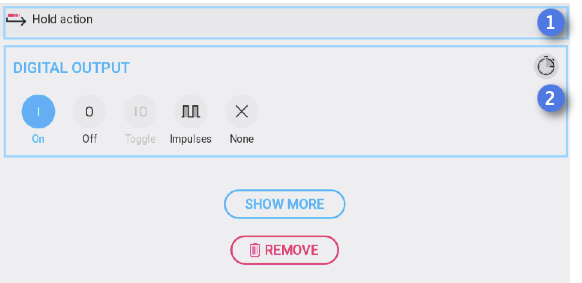
1. Action type - predefined by the system
2. Basic set of actions - most commonly used for the chosen output device type
Advanced (“Show more” button) set
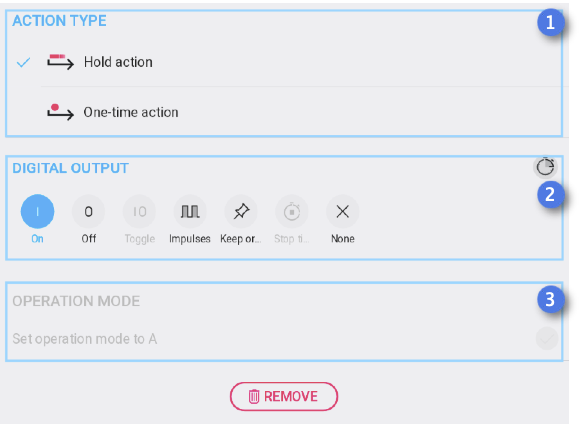
1. Action types - all available options, Hold and One-time (if applicable)
2. Advanced set of actions - all available for chosen type of output device
3. Operation mode - Available for One-time action only. Smart Rule performs an action and set device into Automatic mode (works only when there is another Smart Rule that could take the control over the output). Operation mode switch is very special and rarely used feature
Action types - the way how the action is applied to the actuator

There are two main types of action:
1. One-time action - the action takes place once and immediately afterwards the Smart rule no longer controls the respective output. This type of action is typical for push buttons that works like an impulse but could be used for other devices. Icon for One-time action is not filled, just contoured by accent color.
2. Hold action - the action is permanent, Smart rule controls the device as long as the condition for the action lasts. Icon for Hold action is filled by accent color.
Actions in details

Turn ON
Output device is turned ON

Turn OFF
Output device is turned OFF

Toggle
If the output device is digital output (switch), action turns the switch into opposite state as it was before the action.

If the device is value (dimmer, analog output etc.), action toggle value between 0% and Value (fixed) / Last value (dynamic - value has been set manually or by other Smart rule as the non zero value before the action takes place).

Notice, that Toggle action is available as One-time action only.

Set value
Value of the output device is set to desired level. Available for continuously controlled outputs (dimmers, analog outputs etc.).
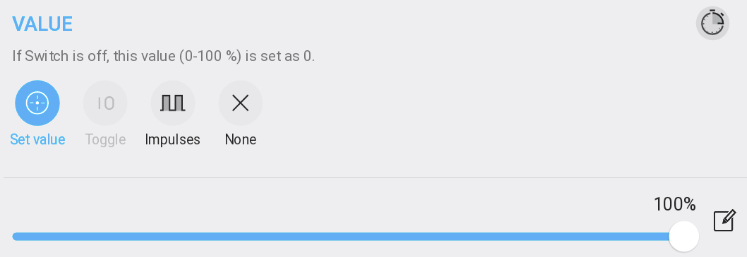

Set range
The device is set to the value from the defined range, which is closest to the last device value before the action


Impulses
Output device is switched between two states/values defined as On and Off
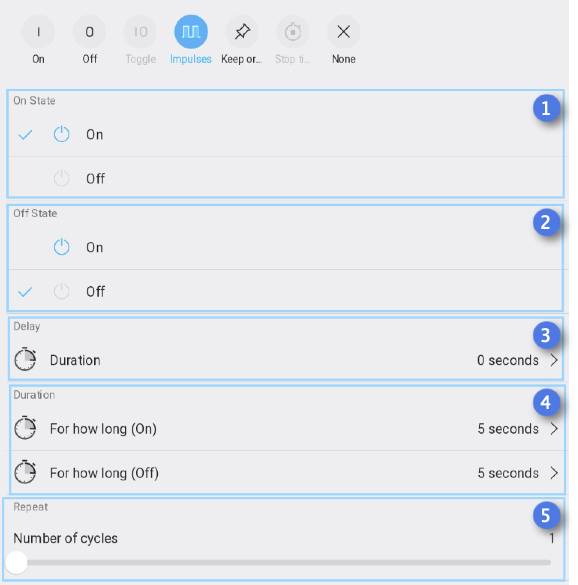
1. On state - what state is considered to be ON
2. Off state - what state is considered to be OFF
3. Delay - Initial delay of the impulse action
4. Duration - time specified for both actions (On and Off)
5. Repeat - number of cycles (repetitions) - how many impulses are generated within the action

Keep original state/value
Output device is keeping actual state/value

Stop timer
One-time action that stops timer action started by other Smart rule

None
No action. Smart Rule does nothing (is bypassed) and makes output device available for other Smart Rule or manual control.

Timer
Allows performing action with some initial delay and duration. As One-time action it performs action once and then leaves output device to be available for other Smart Rules or manual control. As Hold action it performs action for specified time but after that it checks the state of the input device (trigger). If the trigger still keeps triggering state, timer keeps output device in the action state until release. Even then it leaves output device to be available for other Smart Rules or manual control.
Notice that Timer performs specified action only, never set the output device back to state it was before the action.
Combined actions
Continuously controlled devices (analog outputs, dimmers etc.) provide separate control for Switch (On/Off/Toggle) and Value. These duality is supported by the Smart Rule actions so you can choose whether the action affects the Switch or Value or Both. Such advanced feature allows you to control Switch by one Smart Rule and Value by another which is very useful for lighting management etc.
Basic view
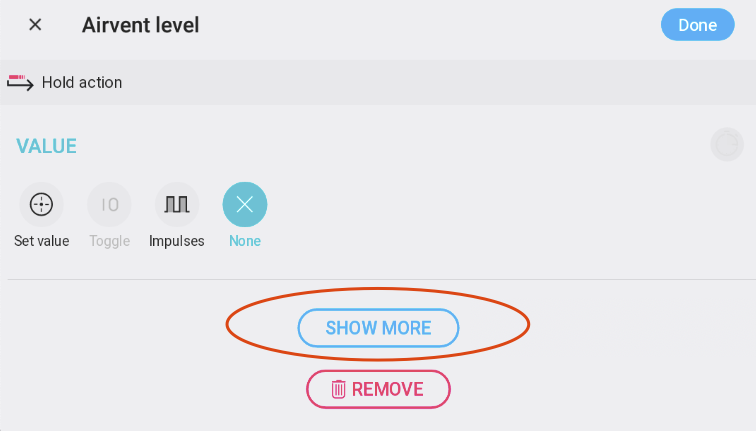
Advanced view
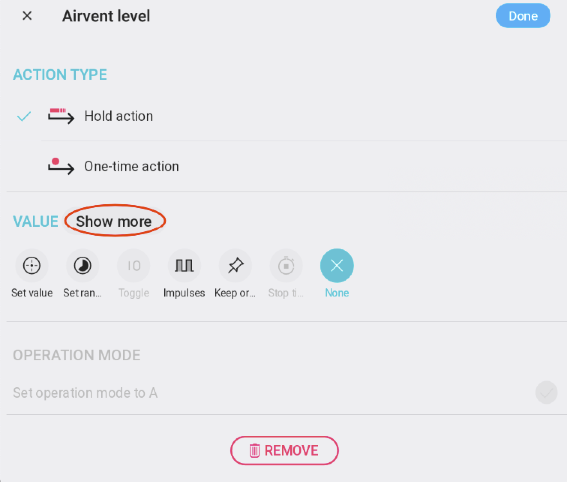
doc_tap_action_value3 ;
Show more - opens menu for combined action
Advanced view with combined action menu
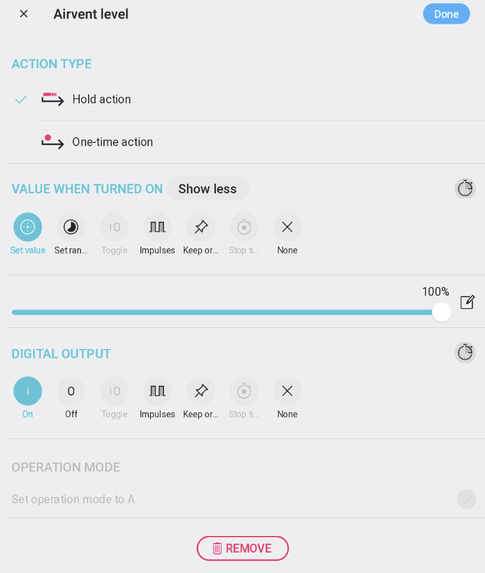
Value - action settings for device value part only
Digital output - action settings for device Digital output (Switch) part only